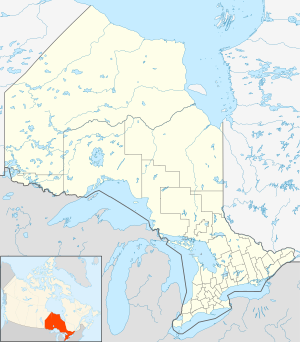| CFS Carp Richardson Detachment | |
|---|---|
| Coordinates | 44°56′12″N76°08′42″W / 44.93673°N 76.1449247°W Coordinates: 44°56′12″N76°08′42″W / 44.93673°N 76.1449247°W |
| Type | Military Radio Transmitter Site |
| Site information | |
| Controlled by | |
| Site history | |
| Built | 1962 [1] |
| Built by | |
| In use | 1962-1994 [2] |
The CFS Carp Richardson Detachment was a military operated radio communications transmitter station linked by landline to CFS Carp located off Lanark County Road 10 East of Perth, Ontario. The detachment was built with a hardened two story underground bunker built to accommodate the Signals personnel needed to operate the transmitter in case of war, as well as a mess hall, sleeping quarters, offices, decontamination facilities, and its own power generation facilities. Its location was chosen to be far enough away from CFS Carp to ensure survivability in the case of a nuclear strike against CFS Carp, and to reduce the risk of interference from its twenty powerful radio transmitters. [1]

A landline telephone is a phone that uses a metal wire or optical fiber telephone line for transmission as distinguished from a mobile cellular line, which uses radio waves for transmission. In 2003, the CIA World Factbook reported approximately 1.263 billion main telephone lines worldwide. China had more than any other country at 350 million and the United States was second with 268 million. The United Kingdom had 23.7 million residential fixed home phones.

Canadian Forces Station Carp is a former Canadian military facility located in the rural farming community of Carp, Ontario, approximately 30 km (19 mi) west of downtown Ottawa.

Perth is a town in Eastern Ontario, Canada. It is located on the Tay River, 83 kilometres (52 mi) southwest of Ottawa, and is the seat of Lanark County.
Separate radio receiver detachments were located and administered by CFS Carp in the region; the CFS Carp Almonte Detachment and the CFS Carp Dunrobin Detachment were linked to CFS Carp by land line also. [3] [4]

The Almonte Detachment was a military-operated radio communications receiver station linked by land line to CFS Carp located in Burnt Lands Alvar off Lanark County Road 49 East of Almonte, Ontario. A second antenna receiver site was located further east near Dunrobin, Ontario; the Dunrobin Detachment. The detachment was unmanned and the location primarily used as a remote antenna farm. After the end of the Cold War, CFS Carp was decommissioned and the antenna site was no longer needed.

The Dunrobin Detachment was a military-operated radio communications receiver station linked by land line to CFS Carp located on the corner of Dunrobin Road and Vance's Side Road NW of Dunrobin, Ontario. A second antenna receiver site was located further West near Almonte, Ontario; the Almonte Detachment. The detachment was unmanned and the location primarily used as a remote antenna farm. After the end of the Cold war, CFS Carp was decommissioned and the antenna site was no longer needed.









